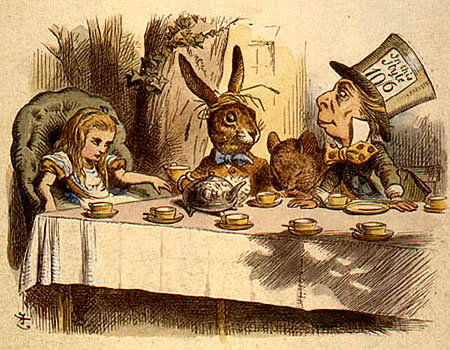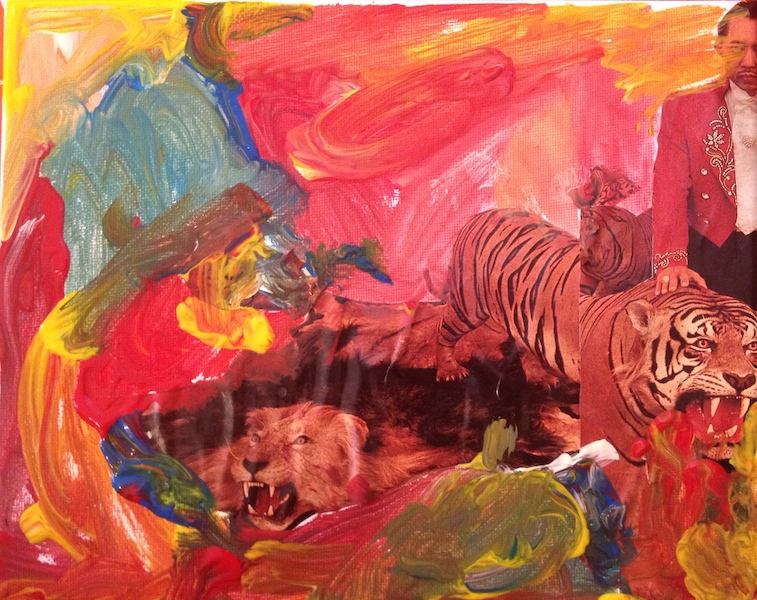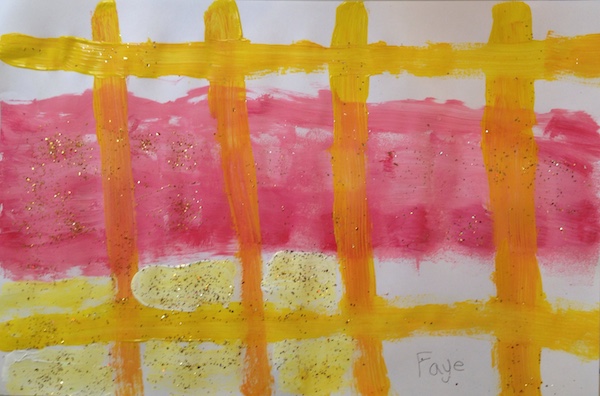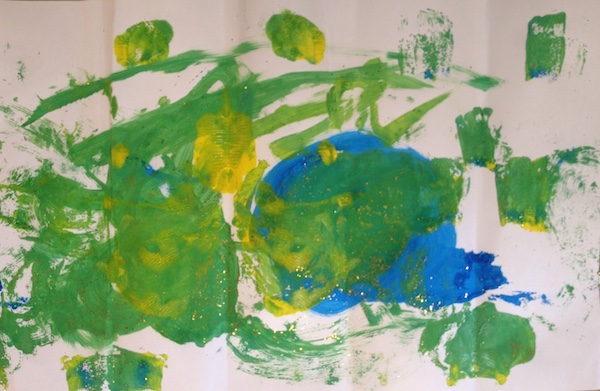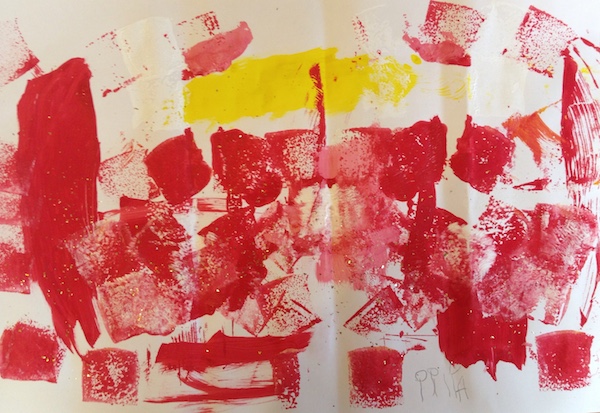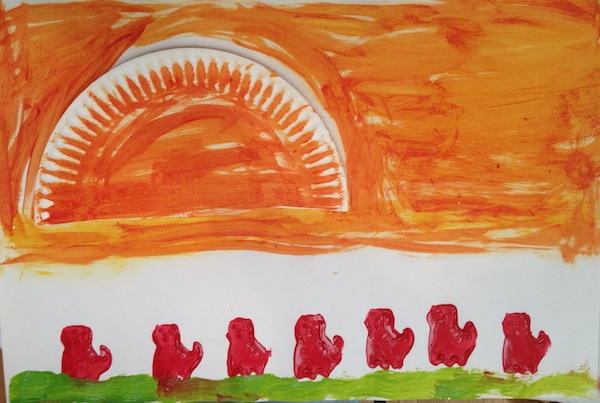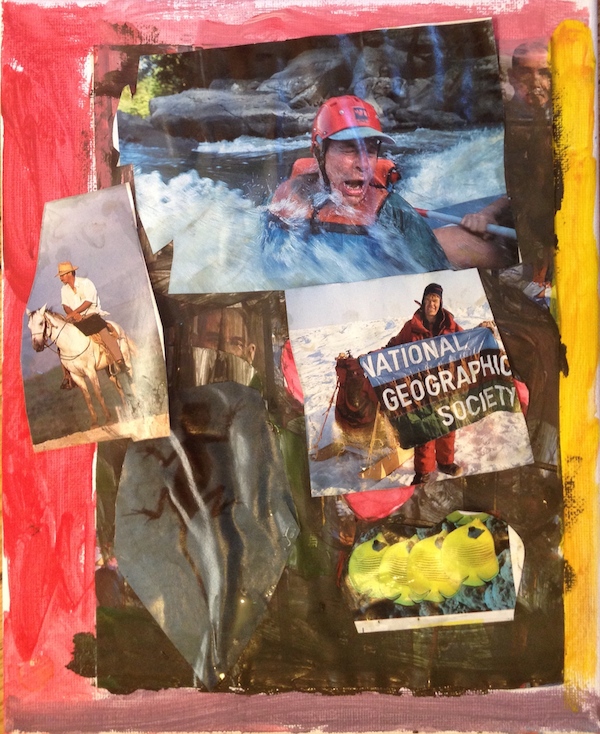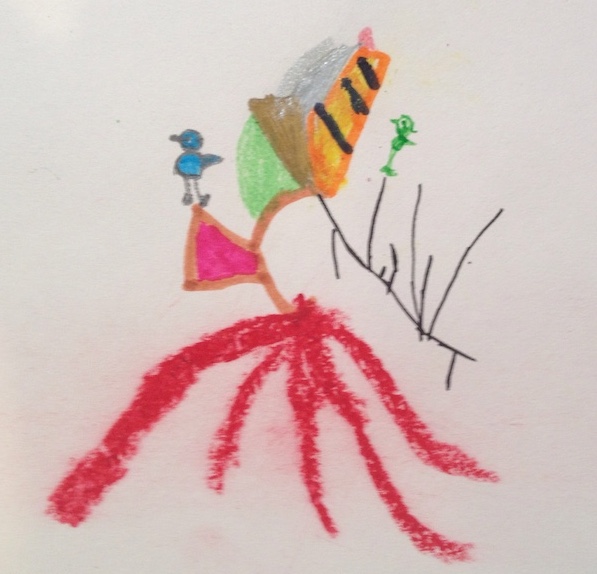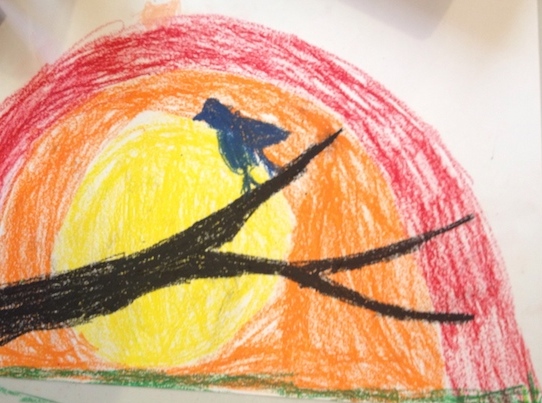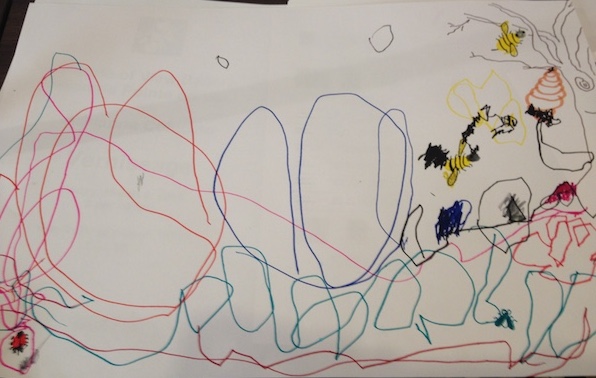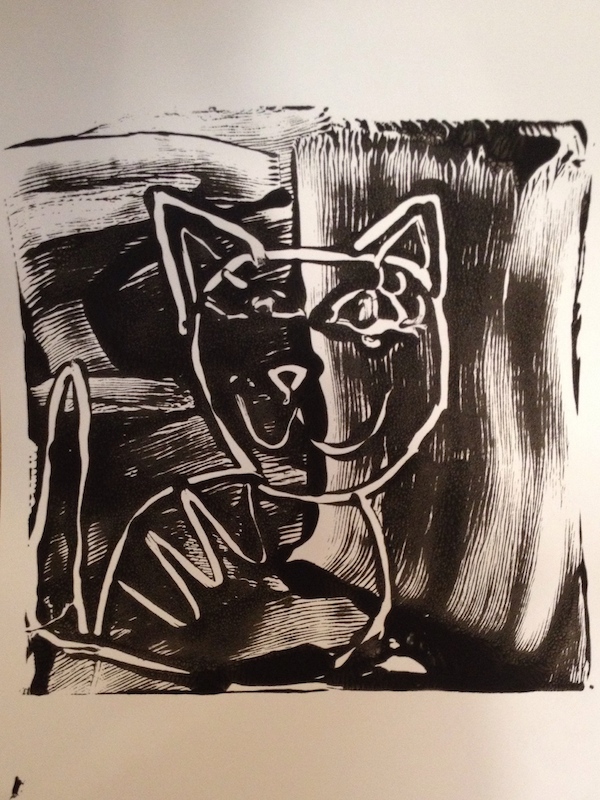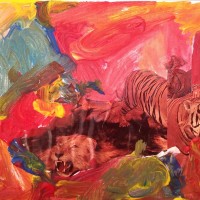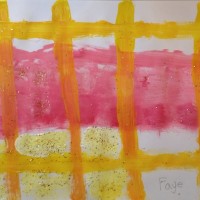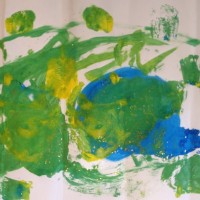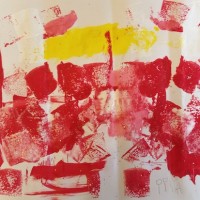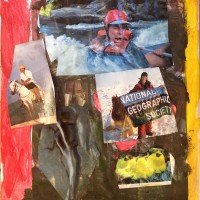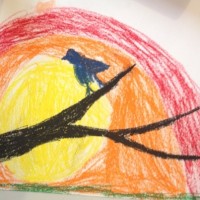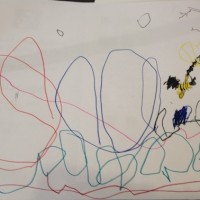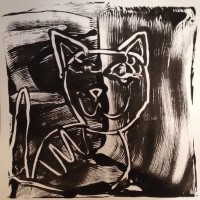by Catherine Wells
Director, Pointe-St-Charles Art School
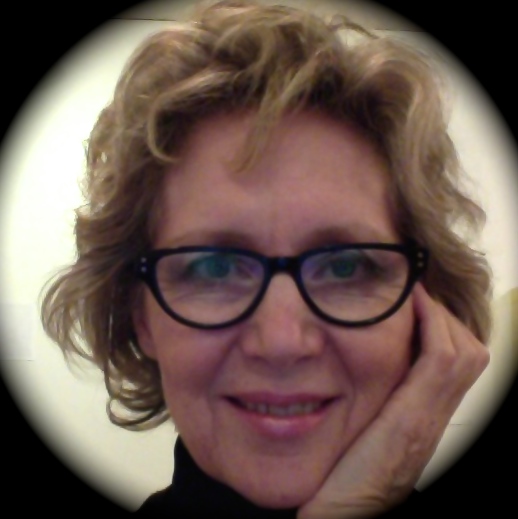
When I was a little girl in the 1950’s, I took art classes at the Montreal Museum of Fine Arts. Arthur Lismer, a member of the Group of Seven, was the founder of the art school there and, although he was not my teacher, he would fly through the studios occasionally and look at all the students’ work. I knew he was a great man. My mother had told me so. Therefore, I was a little in awe of him. My memory is of an intense, agile, tall, thin gentleman in a light-coloured, three-piece tweed suit and a tie – always a tie.
One day, not long before Christmas, he blew into our classroom. He stopped in front of me, examined me and asked if I would like to be in a Christmas tableau. After having ‘tableau’ explained to me, I imagine I must have muttered my assent because, although young and shy, I was flattered by his attention and wanted to take part in what sounded like a play.
It turned out to be a reenactment of a Medieval painting of the Nativity. I was, a little disappointingly, to be a shepherd and not, as I had hoped, Mary. My haircut assured that. But it probably also assured my participation in Lismer’s theatrical production. I had a Dutch Cut. In my painting smock it seems I looked quite like the medieval page.
I was told to go home and make a short skirt like a page’s (he showed me a picture) and he was quite insistent that I made it myself (I was about 9). I told my mother this and I guess she couldn’t accept that I would stand up in front of a cultured Montreal audience in a skirt of my own making. So she made it for me. It was corduroy with a wide ribbon belt. I wore it with my beige school stockings and my artist’s smock.
Back at the museum during rehearsal Mr. Lismer asked me if I had made my skirt myself, and he was annoyed and I was embarrassed when I said no. Oh, the helplessness of childhood!
We rehearsed. It wasn’t hard: we just had to get into our positions as he directed according to the painting, and not move. This he emphasized over and over.
The big day came. We were in a large room in the museum, an auditorium I think, and it was filled with people standing and waiting for the Arthur Lismer Christmas Tableau to be unveiled. We got into our places and were reminded again – DO NOT MOVE – no matter what! The semi-sheer white curtains opened and the light shone down on us. Even from my stand-point behind and slightly to the right of Mary we were beautiful! I remember it as a wonderfully mysterious glow. I gazed down at the Holy Family, still jealous of Mary, but nonetheless transported. Beyond them I could see a mass of quiet faces in the semi-darkness focused on our scene. I really felt part of a painting – a part even of the Nativity. The desired effect had been sublimely achieved.
After hushed noises of approval from the audience, the curtains began to close. They closed halfway, then stopped. This wasn’t supposed to happen. We waited and waited. The curtains were stuck! We didn’t move a muscle. We just waited for the curtains to close. But then it must have gotten to be too much for Mary, because she reached right up out of that painting, leaned over the head of the Baby Jesus, and pulled the curtains shut!
My heart pounding with fear and curiosity, and without moving a muscle, I looked to my right. There, just off stage, I could see and hear a stifled explosion from the great man.
Merry Christmas Everyone!
The post A Christmas Memory appeared first on École d'art Pointe-Saint-Charles Art School.
]]>
by Julia Griffiths–Nadeau
Volunteer, Pointe-St-Charles Art School
Julia G. N., is a volunteer at the Pointe-St-Charles Art School. Her commitment to the school began as a placement for an embedded artist Theatre class at Concordia University. The class was an interdisciplinary effort that allowed students to experience unique community-engaged efforts in the Pointe.
You can learn more about the class through their site: http://righttothecity.atwaterlibrary.ca/
Another interesting outcome of the class is a memory-scape map of the Pointe, using interactive Geo-locators to mark historic highlights, and bring attention to current artistic projects happening in the neighbourhood: http://rtc.cohds.com/
Because of her positive experiences with this project, Julia has decided to continue working with the school, in her new capacity as a regular blog poster. She is a striving creative arts therapist, dedicated to understanding the ways in which art can illuminate the unconscious and distance us from our sufferings. Community-engaged efforts are of utmost importance to her, and she is deeply inspired by the selflessness and determination offered by the founders of Pointe-St-Charles Art School.
Keep a look out for her upcoming entries, and for now, enjoy the outcome of her placement here at the school by way of listening to her final project! A three-minute audio file, edited in collaboration with Russell Donohue, which ‘affectively compresses’ the musings of some of the hearts and minds of the school, a journey into the essence of the space
Consumation by Julia Giffiths-Nadeau performed at Share the Warmth, Saturday, December 5, 2015
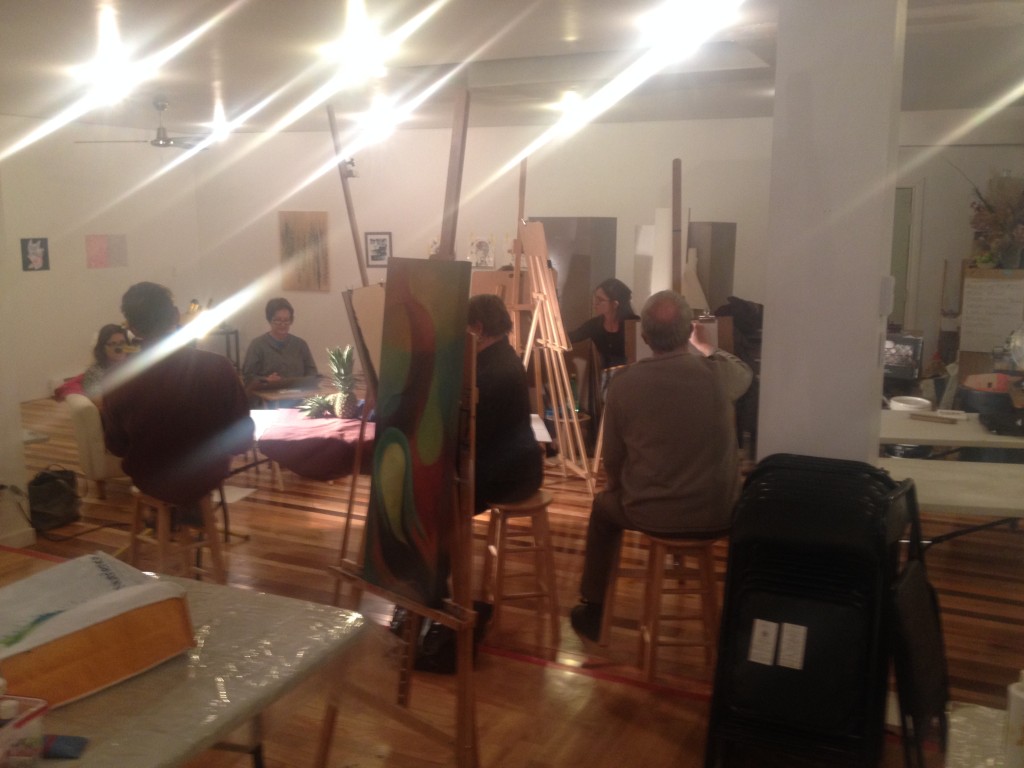
Perspective Drawing Class
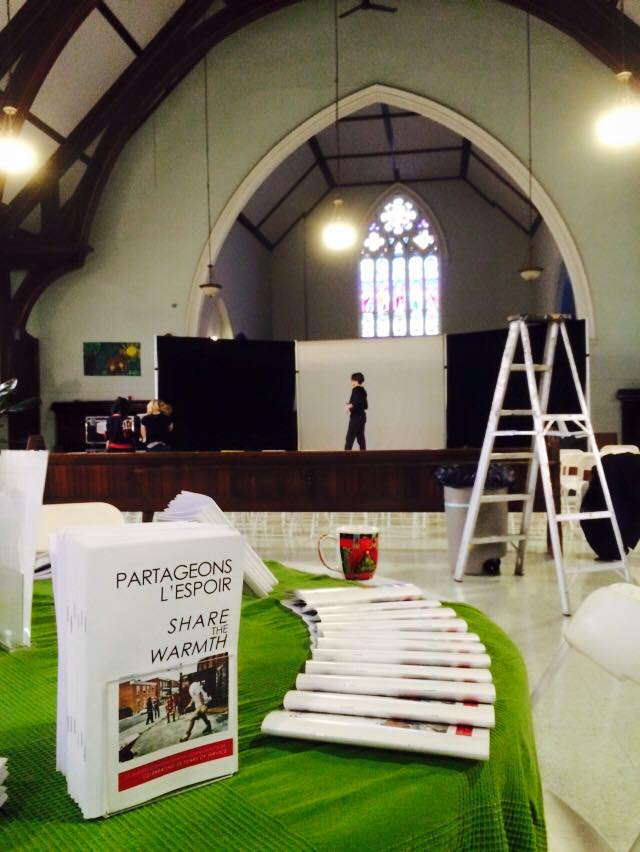
The post A new Blogger is Born! appeared first on École d'art Pointe-Saint-Charles Art School.
]]>
by Catherine Wells
Director, Pointe-St-Charles Art School
“If everyone was an artist there would be no war.” This said to me by an Iranian taxi driver as he dropped me off in front of the art school. How true. I think about this a lot, and it is probably one of the reasons why I work to get people interested and involved in art.
Throughout the twentieth century two world wars, economic depression and social upheaval occurred at the same time as the good life was touted for all. The twenty-first has added its share of war and economic uncertainly, as well as the recognition (finally!) of the effects of a clash between nature and human activity; not to mention that the optimism of the young for a good life for themselves and their children is eroding – and being eroded.
All though human history, artists, poets, philosophers, dreamers and all thoughtful individuals keep working on the idea of what humanness is and can be – of humaneness. It’s an ongoing struggle to hear their voices and ideas amidst the forces of greed and ignorance and the effects of abuse and poverty. A tension arose and continues to ensue between the forces of corporatism and humanism – between institutionalized war and and a vastly unfair distribution of wealth – and an ongoing struggle on the part of many to improve human rights, accept human responsibilities, and develop a just global society.
However, it is one thing to be a pacifist artist who has no personal experience of war and speak like this, and another to spend time with people who have actually gone to war. Carlo Valle, a volunteer at our school, is a former U. S. marine. I met him “on the phone” when he was soliciting donations on behalf of my – and now his – alma mater, Concordia University. A wonderfully curious and amiable man, he wanted to know all about the school and what we were doing here, and then offered his considerable talents, energy and goodwill to help us out. He answers phones and makes calls, takes notes, meets and greets, works on our business plan, databases, scheduling, and so much more. His enthusiasm for our cause is inestimable. And during our busy days we do manage to find time to have some marvelous conversations. It is interesting for me to hear his “war stories” and his educated ideas about the complexities, follies and inevitability of war. I am introducing him in this blog as he has just written an essay called War and Wisdom. Read it here: https://medium.com/point-of-decision/war-and-wisdom-11508832ff55
Like Carlo, a committed individual has always been willing to struggle with the truth and attempt to show it to others. This is the work of each of us who chooses it; who elects to seek out the creative spirit and engage it; to feel discomfort and take up the struggle against injustice; to pursue the truth, personal and philosophical; to grow with the process and take responsibility for oneself and respond to society and each other with respect and integrity.
That is why it is so important to foster individual development – and art is an especially good way to do this: it can make us feel fulfilled and productive, so we can contribute to our society and culture and leave behind us wonderful, helpful ideas and objects so others in turn can evolve. We human beings, in our peculiar capacity to project our inner world onto the outer, may one day be able to humanize the world with the best of what we find within and imagine it into “something like a materialized soul” (Ortega Y Gasset).
I imagine my taxi driver would agree – perhaps if we had had a longer ride…
The post Make Art Not War appeared first on École d'art Pointe-Saint-Charles Art School.
]]>“Abstract Painting” (Purpose, Influences and Coincidence)
by Barry MacPherson
Programming Director, Pointe-St-Charles Art School
Recently I participated in a Two-Man Exhibition with artist John Pohl “Products From The Mind Factory”. I exhibited a series of twelve Abstract Paintings titled “Songs and Lyrics I Remember”. I am not the first artist to paint to music, as Wassily Kandinsky listened to musical notes and compositions while painting.
Excerpt on Wassily Kandensky referenced below.
( Kandinsky believed that colours provoke emotions. Red was lively and confident; Green was peaceful with inner strength; Blue was deep and supernatural; Yellow could be warm, exciting, disturbing or totally bonkers; and White seemed silent but full of possibilities. He also assigned instrument tones to go with each color: Red sounded like a trumpet; Green sounded like a middle-position violin; Light Blue sounded like flute; Dark Blue sounded like a cello, Yellow sounded like a fanfare of trumpets; and White sounded like the pause in a harmonious melody.)
One of the paintings I did was titled “Strawberry Fields“. After a piece is finished I ask myself if it is truly done, does it work, etc. I would not even venture to guess the number of times I had listened to this song since its release in 1967 and knew the lyrics inside out… While in the process of making this piece I was so intent on painting to the sounds I heard I missed something so very obvious. It was the line, “Let me take you down to Strawberry Fields where nothing is real”. It was only then the thought occurred to me that out of the twelve paintings, the lyrics of this song actually define Abstraction.
Wassily Kandinsky, Concerning the Spiritual in Art (Über das Geistige in der Kunst), 1911
Strawberry Fields” (Lennon and McCartney), * Actually a John Lennon composition.
Image above: “Strawberry Fields” 46 x 36″ acrylic on canvas, 2015
Artist Barry MacPherson
The post Abstract Painting appeared first on École d'art Pointe-Saint-Charles Art School.
]]>Dear Edith and Raymond,
I hope all is well with you. Oswald and your auntie came over for tea yesterday. Actually, Oswald only drinks coffee, but Auntie and I are usually experimenting with new and unusual teas with mysterious names like “Dragon’s Pearls”, “Oolong and Ginseng”, “Silver Needle”, “Golden Monkey”, “Emperor’s Clouds” and such…
We were having a discussion about art – which shouldn’t surprise you! As you know, I am always saying that art can be about anything and to prove it I googled “art and tea”. What came up in the search was so interesting that I thought it would be fun to share it with you. As you know, I have a bit of a tendency to be a bit school-teacherish and added some comments to explain them – but you don’t have to read about them if you don’t want – the art, like all good art, speaks for itself.
People started drinking tea in China a long, long time ago. And the Chinese were the first people to make drinking it a ceremony, something special that people did together to enjoy themselves and relax. Here is a very old painting called Tea Party In Hui Hills by the most famous calligrapher and artist of the Ming Dynasty, Wen Zhengming done almost 600 years ago.
The Japanese who live right next to the Chinese also drank tea they (they learned this from the Chinese), and they had special tea houses and a lovley tea ceremony they became famous for. I actually don’t know when this painting was done or who painted it but I thought it very pretty.
In Russia, people make tea in a samovar which you can see in this charming painting by Abram Arkhipov done in the 1890s. Samovars were very simple for the peasants or very fancy for royalty. But whether formal or imformal, tea drinking was and is a very important part of Russian life. Here they even have their samovar at a picnic!
This painting, called 5 O’clock Tea, was done a long time ago, in 1880, by one of the few women painters who were around. Her name was Mary Cassatt. It wasn’t really fair that women weren’t allowed to do the same things as men – but she managed to be quite successful. She painted many scenes about women’s home life, which was unusual for the time.
In this picture, it looks like they are listening very carefully to someone, doesn’t it? Must have been an interesting tea party – wish I could have been there. And the silver is very nicely painted, don’t you think?
One of the most famous tea parties of all time: The Mad Hatter’s Tea Party! John Tenniel illustrated this wonderful children’s book, Alice in Wonderland, that we are all so familiar with, in 1860. His pictures are the most famous of all the illustrations ever done for the story. Even Walt Disney was influenced by them when he made the cartoon version. It’s hard to say, but it doesn’t look like Alice is having all that great a time, does it?
Oswald joked that perhaps the cup of tea will help this lady pull herself together (hee hee). This is done in the cubist style which was a very new way of painting about 100 years ago. It is called Woman with a Teaspoon done in 1911 by Jean Metzinger. Cubist painters wanted to show that they looked at things from many points of view at the same time.

This is a really weird one. It’s what they call Surrealism – which is making what couldn’t possibly be real to look real. It is called Object and was done by a woman artist also, Meryl Oppenhiem, who loved to be unusual. She made this in 1936 and it was quite outrageous at time.
This isn’t a picture of a tea cup or a tea ceremony but it is about a story of a tea party that I heard about a long time ago when I was in university. My teacher told it to the class.
When he was a young man, he was invited to tea by a famous Canadian painter called Emily Carr. She was quite eccentric (remember we used that word when we were describing Oswald? – he was quite flattered, by the way).
Well, when my teacher went to visit her, she had forgotten she had invited him and said the only thing she had in the house was a head of lettuce. She went and got it and put it on the table, and at that moment the third creature in the little cabin, her pet monkey Woo who you see in this painting she did in the 1930s or 40s, swooped down from the rafters and grabbed it and took it back up to her perch in the ceiling. And that was the end of the tea party!
I received your paintings by the way and have them up on the wall at the art school – they are very beautiful and admired by all. Thank-you very much.
I’ll write again soon – and send some sketches for your Tree House gallery next time.
Cheerio,
Catherine
The post The Fine Art of Tea Time appeared first on École d'art Pointe-Saint-Charles Art School.
]]>by Catherine Wells
Dircetor, Pointe-St-Charles Art School
“We need to retrieve the third eye of imagination.”
“Yay! Right on!”, exclaimed Oswald who sat up out the doze he was settling into before I turned on the radio.
We were driving out to the Eastern Townships last week listening to The Current on the CBC. Azar Nafisi was speaking.
She was talking, passionately, about her new book, The Republic of Imagination, or rather about her ideas – and ideals – which are expressed in this book.
Oswald is an easygoing guy in many ways, but he has no patience for dullness. And dullness has been on his mind lately.
After listening for a while he cried out again, “Imagination is in danger! So that means we’re in danger.”
“Shh – let’s listen to the rest of the show…. “ Which we did.
Ms Nafisi kept saying over and over how important it is to develop our imaginations. How we need them to understand a difficult world and what it means to be human. We need to imagine a better world and then work towards that world in our actions, in our work, in our political choices and in our communities.
Imagination changes the world because it makes us visualize the future or at least the kind of world we would like to live in. Artists are great at doing that.
Over the centuries – over the millennia – artists applied their imaginations, using art skills, invention and hard work to understand and express what they were exploring with their minds and hearts and what their images were revealing.
Cave Painting, Altamira, Spain, ca. 16,500 – 12,000 BCE
It is still a controversy in many circles whether cave art was just a historical rendering of what was going on – or, as Nigel Spivey says in a brilliant BBC documentary series and his book, How Art Made the World, (and I go along with him), that it was the beginning of the expression of the inner life. The reaction to deep emotions felt by our early ancestors in the face of terrible fear and uncertainty. Although living in the same world and in many cases under the same conditions as animals, they differed in that they retained memories and could anticipate events – often very scary ones. These early depictions could well have been made to empower the cave dwellers and show them that they were capable of taking charge of themselves in this wild environment, its known and unknown terrors and its undiscovered joys.
The Egyptians, along with many other early societies, started to become very sophisticated in controlling this environment with a very powerful culture. And they communicated this power through images which became a language – hieroglyphics. Their pictures and symbols were often the interaction of animals and people as were the cave drawings but they took on a much more elaborate significance, representing gods and goddesses which in turn represented aspects of human experience and emotion. They showed people what they could be in this life, and that they would continue to exist in an afterlife.
The Greeks – also with a pantheon of deities – went a step further and in their stories depicted through images, very often on urns and other pots that were everywhere, spoke of human behaviour and its consequences. Although gods and goddesses were almost always players, they told human stories – of human behaviour and emotion: war, love, lust, jealousy and death, and all their ramifications. You just had to see what kind of trouble someone – human or divine – was getting into to consider perhaps doing things differently – or perhaps to be inspired by their tenacity, or at least understand that even a god could be confused by the human heart.
This particular pot tells an intricate story of Zeus’s love of Io and his infidelity, Hera’s jealousy and rage, the ensuing adventures and eventual happy ending. To read more, go here: http://www.theoi.com/Heroine/Io.html
Stained Glass Windows of Notre Dame Cathedral, begun in 1163, Paris, France
During the Middle Ages, Medieval art turned away from the natural world in an attempt to control it through the expression of the spirit. The nature religions of gods and goddesses were replaced by Christianity. Cathedrals soaring up into the sky with spires and gorgeous stained glass windows lifted people’s eyes to the heavens and to the invisible world of the spirit – to imagine a painless afterlife of beauty and eternal peace. And for a brief moment, through the art, they could have a taste of it.
Michelangelo, The Creation of Adam. The famous fresco on the ceiling of the Sistine Chapel in the Vatican City was painted from 1511 to 1512
Western culture and individual expression flourished during the Renaissance. A rediscovery of ancient classical philosophy and art brought forth a renewed humanism after it had been set aside by the ecclesiastical and metaphysical systems of the Middle Ages.
Although much of the subject matter remained religious, the Renaissance saw the return of the sensual to life and to art. But more importantly, for the imagination, the possibilities open to the human mind exploded. Through the incredible technological advances in art in which artists had much more control over how to depict what they wanted to depict, they began to show the world possibilities never before dreamed of, and a technical skill never before achieved.
Eugene Delacroix, Liberty Leading the People, 1831
Romanticism grew out of the failure of the Enlightenment to eradicate human misery. The wonderful ideas of that period could not stand up to a crushing class system. As the free-wheeling, in comparison, Romantic Age unfolded, the worth of every human being was proclaimed and this reverberates to our present day. Revolutions abounded and although terrible in their scope, earned the Western World much of the freedom enjoyed in our present times. As the artists became more individualistic, they showed people that this was possible for everyone. They urged people to imagine a world in which humane societies and individual development are achieved.
Auguste Renoir, Luncheon of the Boating Party 1881
As a new era began to dawn along with politcal changes, industrialization and technological advances, artists began to embrace art for art’s sake. Now that the camera had arrived on the scene, art was no longer as important as a tool for rendering. The Impressionists and the Post-Impressionsts showed the full power of art and its components could be felt and developed as an end in themselves. Light, colour, composition and subject matter celebrated the beauty of life and an ideal to strive for: every day could be a sunny day, and every gathering an occasion for joy – for everyone, in spite of the difficulties of life.
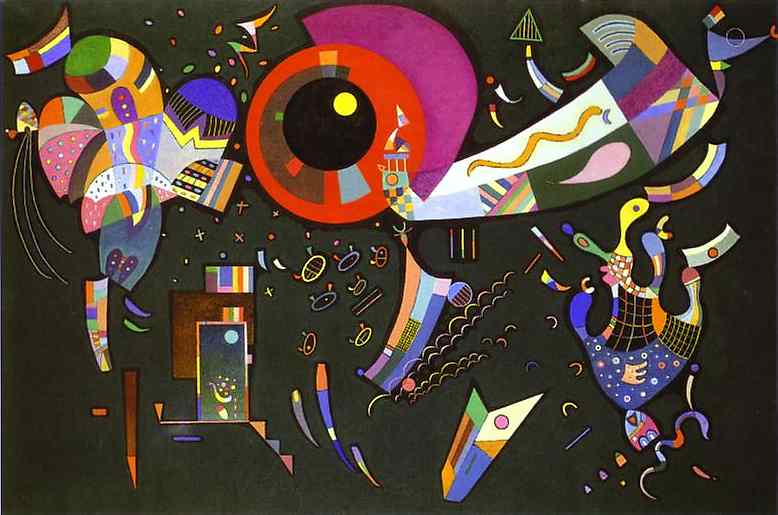
Wassily Kandinsky, Around the Circle, 1940 Oil and enamel on canvas
When World War 1 occurred, these hopes were dashed. Artists imagining a new world were devastated. Wartime and post war art was bitter, though often still beautiful. But at the same time, a new spirituality arose in the form of abstract art. An interior world that could not be dashed by politics or war. Symbols became paramount again and artists such as Kandinsky strove to make visible the depth, variety and beauty of the inner and abstract life.

April Gornik, Light Before Heat, China 2004
Who to choose among present day artists? Out of the many I could, I choose April Gornik. She paints landscapes, often from her imagination, I have read, and shows us a beautiful, natural world that is still available to us – within and without – despite the fears and stresses a contemporary era lays upon us. Different fears and stresses than our cave ancestors experienced but as deeply felt – and as deeply soothed by beauty and the imagination. She shows us that the unknown is still there to be explored and there are joys yet to be imagined and discovered…
All of these artists were not just daydreamers. They honed their skills, seeking excellence, and their imaginations, seeking truth. They worked very hard and diligently to best express their daydreams, imaginative flights of fancy, and hopes for the future.
They fulfilled the splendid capacity of the human being to be able to focus on the life within and the life without, and imagine a world into existence.
This brief outline is a mere (personal) glimpse of what art and the human imagination has done for us – and what we have done and can do with it. We cannot let the world get swallowed up in a sea of corporatism – either through the cutthroat antics of consumer art or cuts to arts funding especially in the schools. Support the arts in your community – and even more important, develop your own imagination in every way possible to be able imagine an ever better world for yourself and everyone else.
Oswald is a poet and we can end the blog with his poem – that he made up in the car ( I helped a bit).
Imagination is what we are;
vision guides us to the unknown.
The unknown cannot really be discovered,
therefore, our journey is never in vain.
Imagination shows us how to be;
images are our mentors and our comfort.
Comfort cannot deceive us
if we desire and imagine the unknown.
The post Imagination! appeared first on École d'art Pointe-Saint-Charles Art School.
]]>by Catherine Wells
Director Pointe-St-Charles Art School
What art does for us:
It has been a while since I have done art classes with children – I have been teaching adults, doing my own work and spending every spare moment helping to build our new art school. On Thursday, I did a parent child art workshop and helped a few days earlier with our Saturday children’s classes. It was so wonderfully refreshing to be back in the world of kids making art. They have a lesson to teach us all. And that is the discovery of our world is a life long adventure and art is one of the best ways to get the most out of it.
Here is a quote from the late Robert Hughes, one of the best art critics who ever picked up a pen, who was dedicated to the idea of art as something we need as human beings to be the best of who we are able to be and to revel in the best life has to offer.
The basic project of art is always to make the world whole and comprehensible, to restore it to us in all its glory and its occasional nastiness, not through argument but through feeling, and then to close the gap between you and everything that is not you, and in this way pass from feeling to meaning. It’s not something that committees can do. It’s not a task achieved by groups or by movements. It’s done by individuals, each person mediating in some way between a sense of history and an experience of the world.
The ability to be creative requires the acquisition of skills and the discovery of what one is really interested in, and then learning more about it and how to express it. A fine balance must be struck between the teaching of skills and the encouraging of self-expression. There is a great deal of current research out there which shows that fostering creativity affects behaviour, relationships, emotional expression, school, work and socialization in a very positive way.
In the course of my work and research as an artist, art teacher and art therapist, I have come to learn that the basic human impulse to play, ritualize and make special is the source of creativity and art, and, as we develop, it becomes more complex. Through it the individual evolves; through it the human ability to perceive is enlarged. Each of us uses symbols in art in a way that is personal and expressive of ourselves. A work of art is the maker’s vision: a refined, illuminated and even mysterious revelation and expression of his/her perception. The images we make directly reflect and influence how we think. Art enables us to show how we each perceive our inner and outer lives: what is important, what is not. We use the elements of our existence to do this. Art-making assists us in the lifelong resolution of reality and fantasy, what goes on around us and what goes on in our minds, and thus it fosters individual development and enriches our lives. I know this because of my long experience with art, children and people of all ages. Yet I never cease to be fascinated and enlightened by their discovery of themselves and the world around them through the creative process.
Why art? Because it’s fun and it’s beautiful and it makes you feel good. Here are a few images from our recent children’s classes that have been going on at the school. Certainly, watching them enjoying themselves and taking what they were doing very seriously at the same time, was an inspiration!
The post Why Art? appeared first on École d'art Pointe-Saint-Charles Art School.
]]>Urban sketching has really taken off. There are societies for it, clubs, online meet-up groups and exhibitions. It is a real renaissance!
During the twentieth century sketching in general took a back seat to photography, the brand new technology that was dazzling everyone. Drawing became something one went to art school to do, and its everyday practice as a gentle pastime that had been popular up till then began to fade away. And in particular, pastoral sketching in the countryside was on the wane, not just because of the camera but also as a result of changing demographics.
More and more people are city dwellers now. In 1851, 87% of Canadians lived in the country, and 13% in the city; by 2011, it was almost reversed with 81% living in the city and 19 % in the countryside. (Stats Canada)
The city environment is here to stay, and urban sketchers are saying, “Let’s make the most of it and find the beauty on street corners and back lanes, in industrial growth – and decline, landmarks and heritage sites evoking memories of our predecessors who built them. And at the same time, let’s return to using our hand to capture the image and not let modern technology distract us from that skill used for so many centuries by human beings.”
Times have changed – and so have the scenes. The industry and modernization that occurred during the late nineteenth and throughout the twentieth century altered the view, so to speak. So as we pick up our charcoal sticks and pencils again, there is a whole new world to depict, along with the remnants of the old one.
Historical Pointe-St-Charles is a particularly attractive place to sketch, with its streets of quaint little houses, pretty parks, train tracks and canal; with its industrial ruggedness and commercial streets with many old fashioned restaurants, bars and shops mingling with new businesses.
The Pointe-St-Charles Art School is starting an urban sketching group. Come join us on Tuesdays from 1 – 4 pm. Choosing a different and interesting location in the Pointe every week, an instructor will be on hand to help out with techniques and helpful tips – it’s only $10. On rainy days, we will find interesting indoor sites – churches, museums, cafés …
And we will be sharing the images in a special online gallery on our Facebook page.
Why sketch with others? Well, it offers inspiration, the exchange of ideas and techniques, feedback and continuity. It is a way to encourage good drawing habits and a routine so necessary for the maintenance of an art practice.
The urban sketchers movement started in 2007 by a Spanish journalist living in Seattle. In 2008, the group started a blog: http://www.urbansketchers.org/
The group is limited to invitation only, but nonetheless has contributed greatly to the renewal of onsite sketching in cities.
FYI, here is their manifesto – a good one for any drawing group to follow:
- We draw on location, indoors or out, capturing what we see from direct observation.
- Our drawings tell the story of our surroundings, the places we live and where we travel.
- Our drawings are a record of time and place.
- We are truthful to the scenes we witness.
- We use any kind of media and cherish our individual styles.
- We support each other and draw together.
- We share our drawings online.
- We show the world, one drawing at a time.
Any burgeoning enthusiasm is usually accompanied these days by many, many reference books. You just need to search online to see the array of wonderful references and how-to texts on the subject.
But there is nothing like working together with like-minded people. Come and join us – bring your books, materials and ideas – let’s make a community here of urban sketchers.
What you need to sketch outdoors:
The Absolute Basics:
- A sketchbook
- Pencils and erasers and sharpener
Optional:
- Something to sit on – a portable stool or chair.
- Other drawing materials of your choice, charcoal, conté, pens, coloured pencils, pastels, paints, etc
- A ruler
- View finder
- Board and clips
- Larger paper
Hope to see you! Check out our site for more information!
The post Urban Sketching appeared first on École d'art Pointe-Saint-Charles Art School.
]]>by Catherine Wells,
Pointe-St-Charles Art School
Edith and Raymond are my two new friends. They are staying with the woman next door for a few days, as their school finished early this year. Edith is her niece and Raymond is Edith’s best friend, and they are both seven years old. I met them at our neighbourhood festival where I was (wo-)manning the face painting booth. Edith wanted to be a fish and Raymond, Bat Man. Bat Man was easy, the fish a bit more of a challenge but, all to say, they were happy with the result and we had become fast friends by the time their faces were done. Edith asked me if I liked being an artist, and I replied that I loved it more than almost anything. “Me too!” she said. She is very earnest and asked if they could come visit our art school.
How could I resist? So once we had done with the festivities, we headed over. We had a grand time. Edith and Raymond settled into the space to make some art. They both knew what they were going to do. Edith pulled out a yellow paper package from the woman next door’s shopping basket – they had come via the Atwater Market – and unfurled it on an art table. It held the brightest and most beautiful stalks of gleaming red rhubarb with vivid green leaves you could imagine. After setting her up with a paint tray, brushes, water, and such, I turned to Raymond. He was already hard at work doing a drawing in his own sketchbook. A bit hard to make out at first but when I asked him to tell me about it, he clearly described the Griffintown Horse Palace. It is the last one standing in Montreal and they had had a look at it the day before. The scene was completely rendered from a bird’s-eye view and it was all there: stables and carriages, horses, buckets of water, roof tops and puddles. It was quite spectacular, and I wished I had his ability to see from space! Looking back to Edith, I saw that she had dashed off an enviable expressionistic rendering of the glories of the rhubarb and the yellow wrapping paper. When I asked why they were such wonderful artists, Edith answered, “Well, we do art all the time, of course. It’s the only way to get good!”
I have spent my whole life doing art with children. Art is good for children, for the development of their creative minds, their imaginations, to discover who they are and what they particularly like to think about – what they find beautiful, or scary, or weird, or funny, or even sad about the world. Human beings develop because something in the human psyche demands it. The creative spirit resides in each of us: it is the impulse which animates our personalities. It unites us and at the same time gives us our unique identities.
School will be out soon and the young people you know and love will be looking for things to do. If you want to find ways to keep them busy and happy, and would like to advance their development through the arts at the same time, here are some practical guidelines to promote artistic expression and creativity:
- Do art with your children but also encourage them to work alone.
- Take cues from your children when you work together – let them suggest to you what to do rather than the other way around.
- Work with your children at their pace and developmental level.
- Allow feelings (even negative ones) to be expressed in the artwork – and talk about them if the child wishes to.
- Set up an art space – a corner of a room with a little table and chair, containers with glue sticks, scissors, crayons, pencils, sparkles, etc., and a variety of paper. Or store art materials in a box to bring out and use at the kitchen table on a regular basis.
- Acknowledge and encourage your children’s artwork – display it: put it on the fridge or frame it.
- Borrow from the library or buy arts and crafts books to get ideas, or look on the Internet.
- Recycled materials and inexpensive items from the Dollar Store can provide hours of artistic expression.
- Give art supplies, music CDs, puppets, costumes, art books, etc., for birthday and holiday presents.
- Go to museums, puppet shows, concerts, children’s theatre.
- Check out the many art classes and art camps in the city.
Unfortunately I won’t be able to show you Edith’s and Raymond’s finished art because they took it home to put into what they call their Treehouse Gallery, where only the very best work goes. I’m mailing them my photo of themselves as Bat Man and the Fish to hang there. I hope it meets with their selection criteria. Meanwhile at the top of the post you can find a little illustration I did of them…
The post Edith & Raymond appeared first on École d'art Pointe-Saint-Charles Art School.
]]>“What’s the weather like?” I asked my friend Oswald who had dropped by for coffee. “Well, the Weather Network is saying to look out for hurricanes, flash floods, and cyclones, Eye on the Sky predicts higher temperatures in the south and cold, warm, rainy, sunny and windy conditions in the Champlain Valley, and the Farmer’s Almanac is advising us to wait to plant cucumbers. I’m going with my phone which says it’s going to rain in 47 minutes.”
I grabbed my jacket and umbrella. We were heading over to the art school. Walking down the street in amiable silence, I thought to myself as I looked up at the sky, how like a painting it was. Weather – it seems so strange and changeable these days, but it always has been a preoccupation of human beings.
It’s always there, and we oddly expect it to be at our beck and call – to rain when we have planted seeds, spread sunshine on our sidewalk cafés, blow wind in our sails and give us a sunny day on our birthday. We depend on it for something as simple as a picnic or as vital as our very survival. We can be delighted or depressed by it, soothed or angered.
Yesterday I was at the plant nursery getting a few pots of pretty flowers for the balcony. It was 31 degrees Celcius and the wind was blowing like crazy: tarpaulins were rattling, the poor plants were being tossed and bullied by the wind. It all made me very annoyed and gave me a headache. When the rain came later in the day, I was relieved. I sat on the balcony with my newly purchased floral companions and watched the storm clouds billow and build. This morning as I shiver over my cup of tea and bring the poor creatures inside to shelter them from the plunging mercury (it is now 9 degrees!), I look up at the wispy clouds and misty sunshine with the knowledge that they are in control of our lives in whatever form they choose to take.
Love the weather, or hate it. Complain about it or accept it. Rail against it – revel in it – we cannot master it. Except perhaps, I mused, on canvas. How often does weather of all sorts feature in our art. Here are a few of my favourite weather controllers.
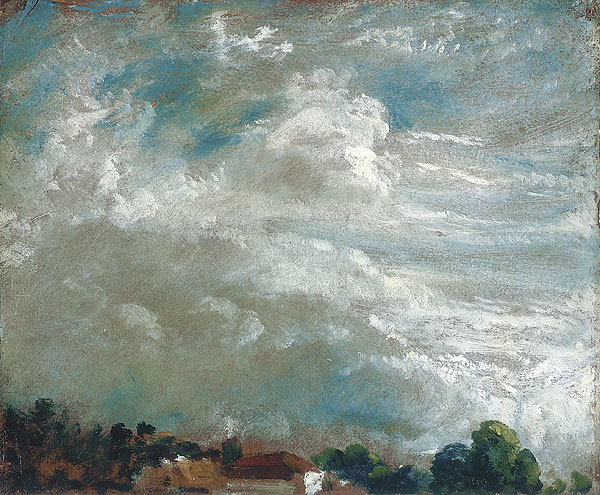
Study of Sky and Horizon of Trees by John Constable
Constable painted the sky over and over. As he lived in England, it offered an ever changing model! It is said he would sit in one spot, paint, turn a quarter turn and paint the next scene and so on. In any case, he certainly depicted the beauty of the changing sky, the important presence it played in country life, and the tininess of human existence in comparison with it.
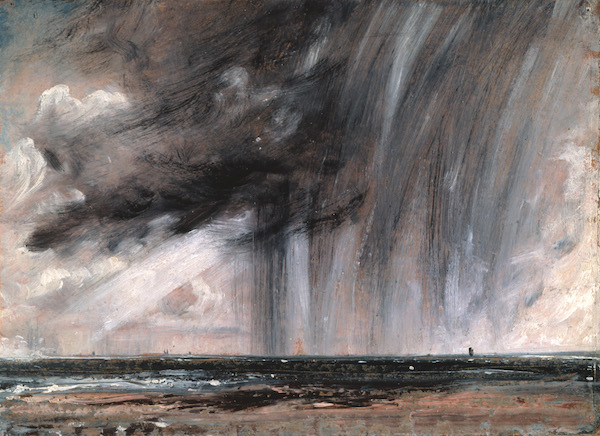
To the left is Constable’s Seascape Study with Rain Cloud and, although done in 1824, it looks very modern, I think.
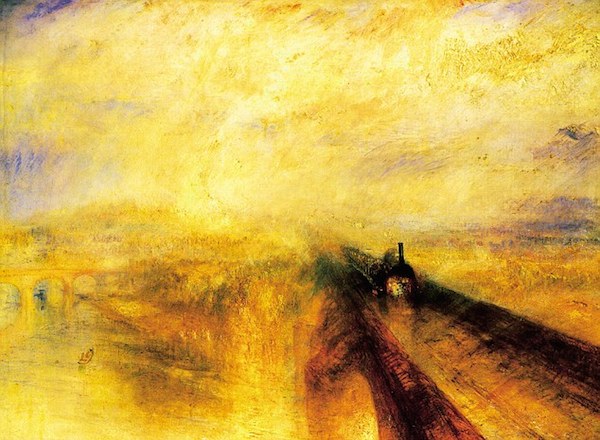
J. M . W. Turner lived and painted in England around the same time as Constable. He took weather painting to new heights with the human element barely obvious. In both these paintings, the powerful steam-driven machines of his time are swallowed up in atmospheric grandeur.
Rain, Steam and Speed – The Great Western Railway 1844
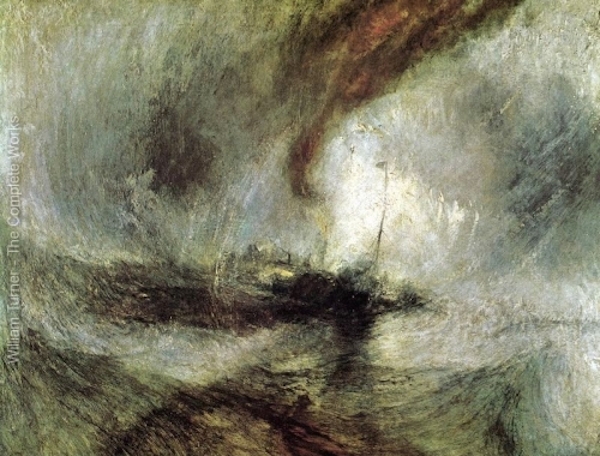
Snow Storm – Steamboat off a Harbour’s Mouth 1842
There’s a great scene in the movie, Mr Turner, that shows him being strapped to the mast of a ship to really get the feel of what that kind of weather was like.

Claude Monet was a French painter also very curious about and enthralled with the effects of weather on his subjects. He did many series of the same subject in different weather and under different light.
Houses of Parliament with Sun Breaking through the Fog 1904 shows sun and fog with the great seat of the British government a mere shadow in the distance.
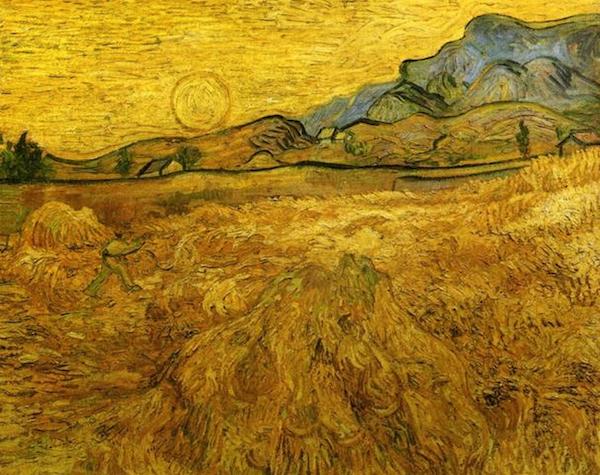
You can’t talk about sunshine without mentioning Vincent Van Gogh. After living and painting in Holland and northern France and mostly in brown tones, he moved to Arles and was dazzled by the colour and light. He wrote to his brother Theo, “How lovely yellow is! It stands for the sun.” From then on, his paintings become the vibrant images that we are so famliar with.
Wheat Field with Reaper and Sun 1889, shows Vincent’s love of the land and the people who worked it. He makes the reaper (very difficult to find in the painting) one with creation and the light of the sun, showing his dependence upon it and his harmony with its power to provide.
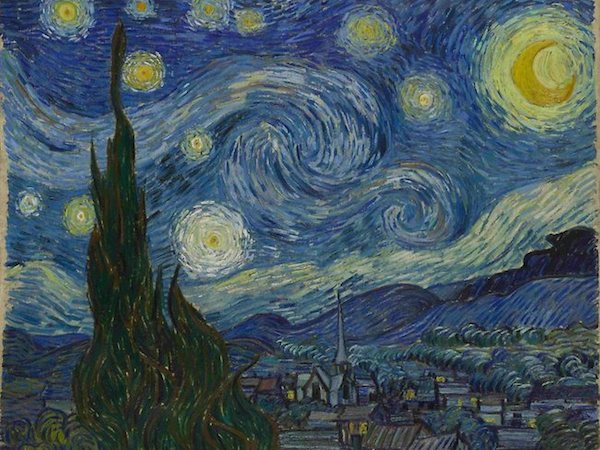
And The Starry Night, 1889, seems to depict so much more that a benign summer’s evening with those great globes of light and wind whirling through the sky above the tiny sleeping village below.
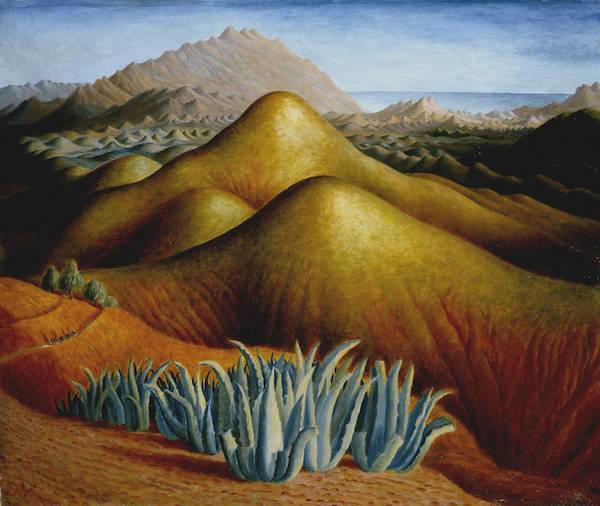
Dora Carrington, though not as well known as the artists above, usually finds her way onto my lists of favourites. Here she paints the hills of Spain. They are eerie in that there seems to be practically no weather. The airless stillness depicts a weird landscape with almost human features that appears itself to be breathing in and out creating its own environment as it does.
Spanish Landscape with Mountains c. 1924

I can’t write about weather paintings and not include the Group of Seven.
How can I choose? These artists, painting from nature and wishing to capture the vitality and distinctiveness of the Canadian landscape at a time when most “colonial” artists were still painting in the Eurpoean style, would go up to Georgian Bay and set up their easels in the wildereness, painting what no painter had done before with such vigour and truth.
Here is Fred Varley‘s Stormy Weather painted in 1921.
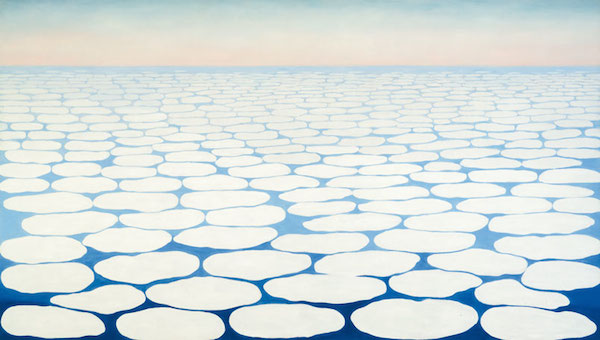
This is Georgia O’Keefe‘s Sky Above Clouds IV painted in 1965 when she was almost eighty. It was an abstraction of her experience of flying above the clouds which excited her very much. This is weather from the “other side”.
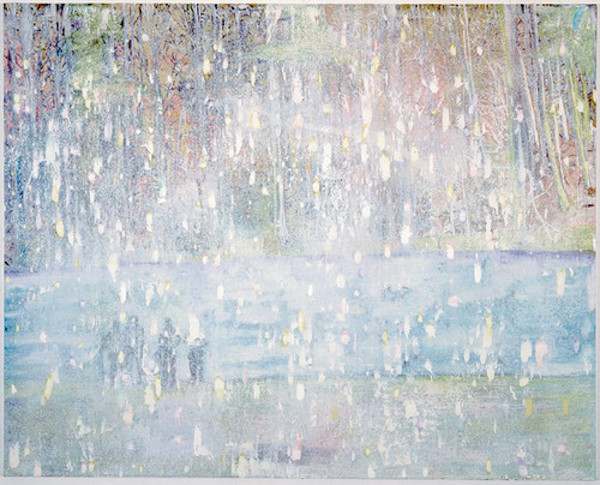
Peter Doig is an artist claimed by many to be a native son. He was born in Scotland, raised in Trinidad and Canada, studied and painted in London and now lives in Trinidad. This painting was done near his parents home in Colburg, Ontario in 1995, before he became rich and famous. The cryptic title, Coburg 3 + 1, does not say much about weather, but I believe the image speaks for itself.

Helen Frankenthaler, one of the few women among the Abstract Expressionists who began working in this new style in New York in the fities and sixties brought a certain upbeat mood to the genre. We can see this in her Basque Beach done in 1958. Here is weather at its finest, in my opinion. Her paint, the sun and wind and sea are one.
So sunny days or stormy, windy, breezy or still – the weather is ever changing and beyond our dominion. But how wonderful it is that art and artists are able to capture it as they do. The image at the top of the page, by the way, is Winslow Homer’s Artists Sketching in the White Mountains done in 1868.
Take some art classes – you too may learn to control the weather!!
The post Weather! appeared first on École d'art Pointe-Saint-Charles Art School.
]]>



